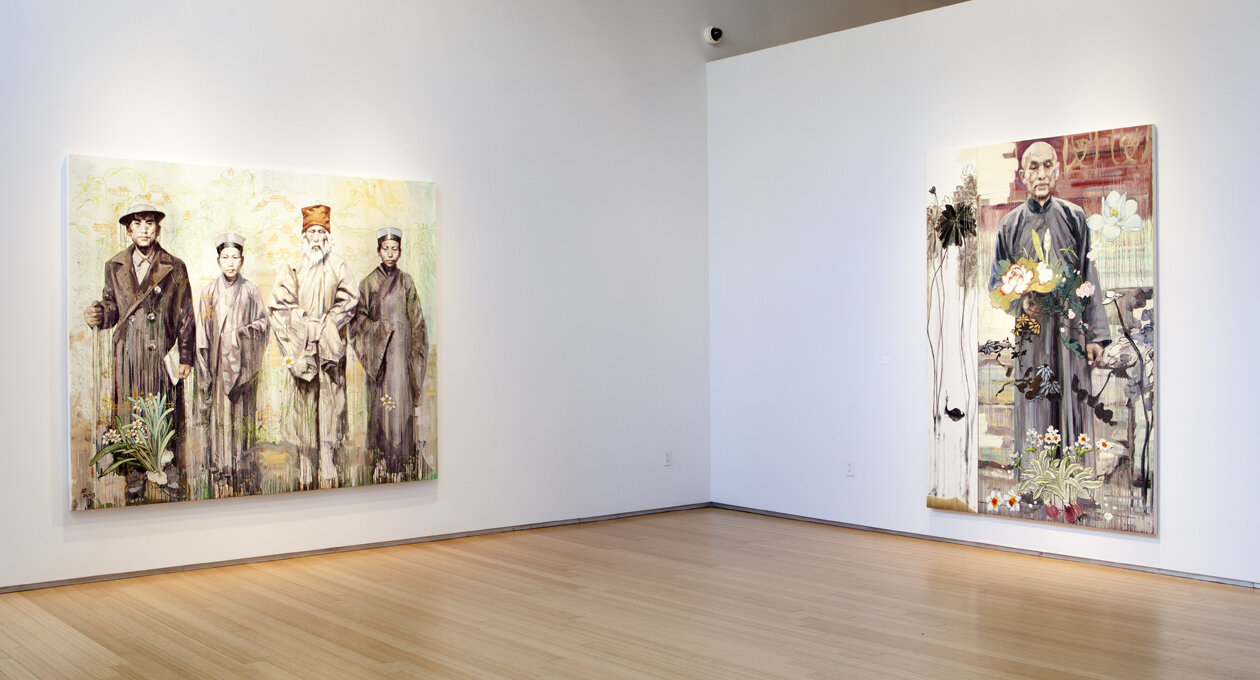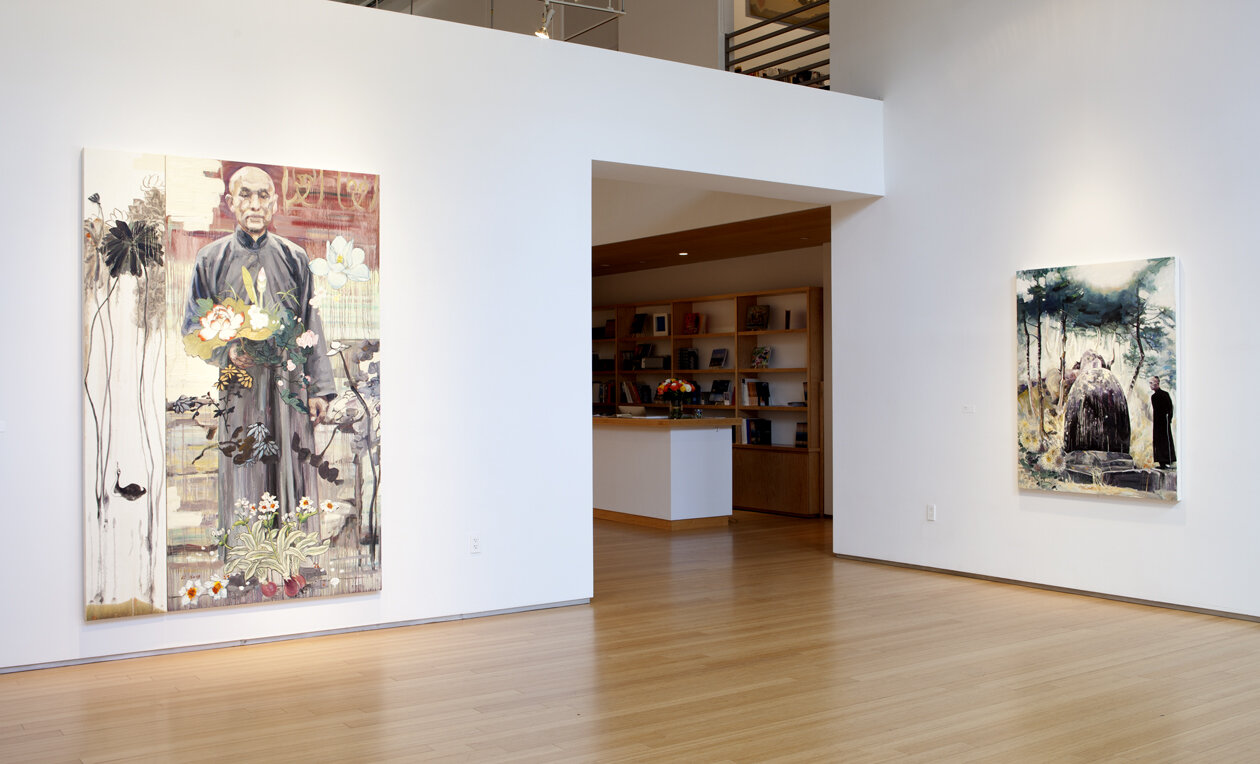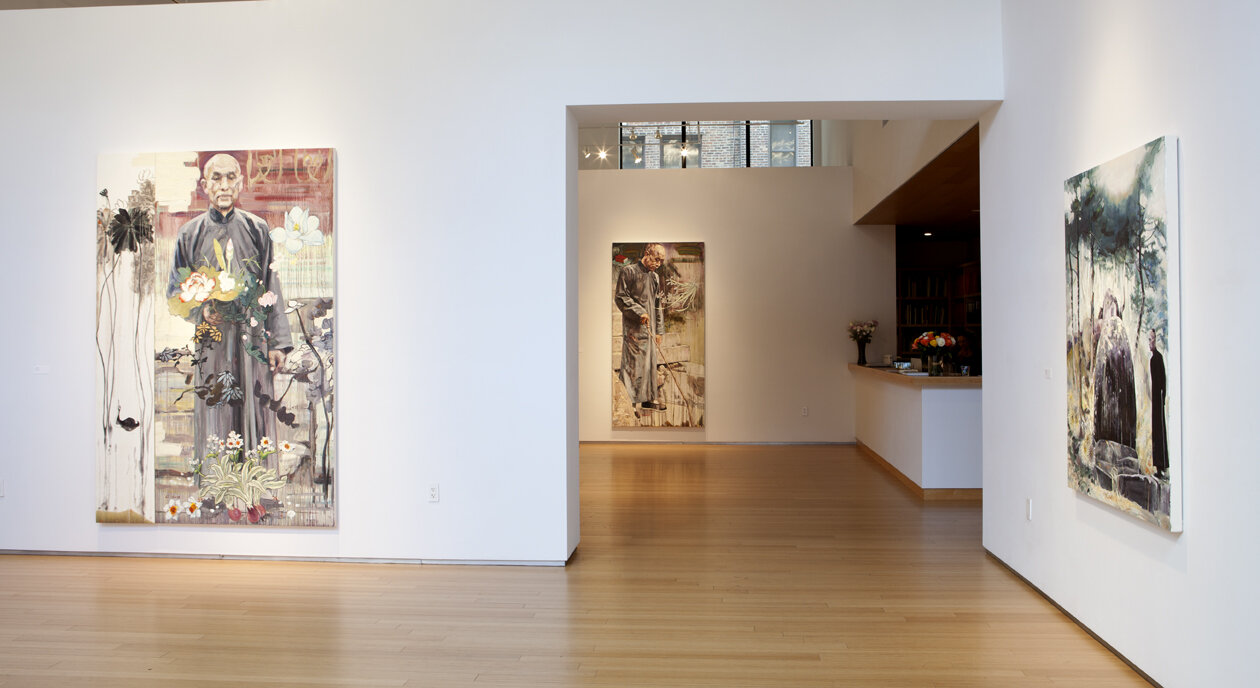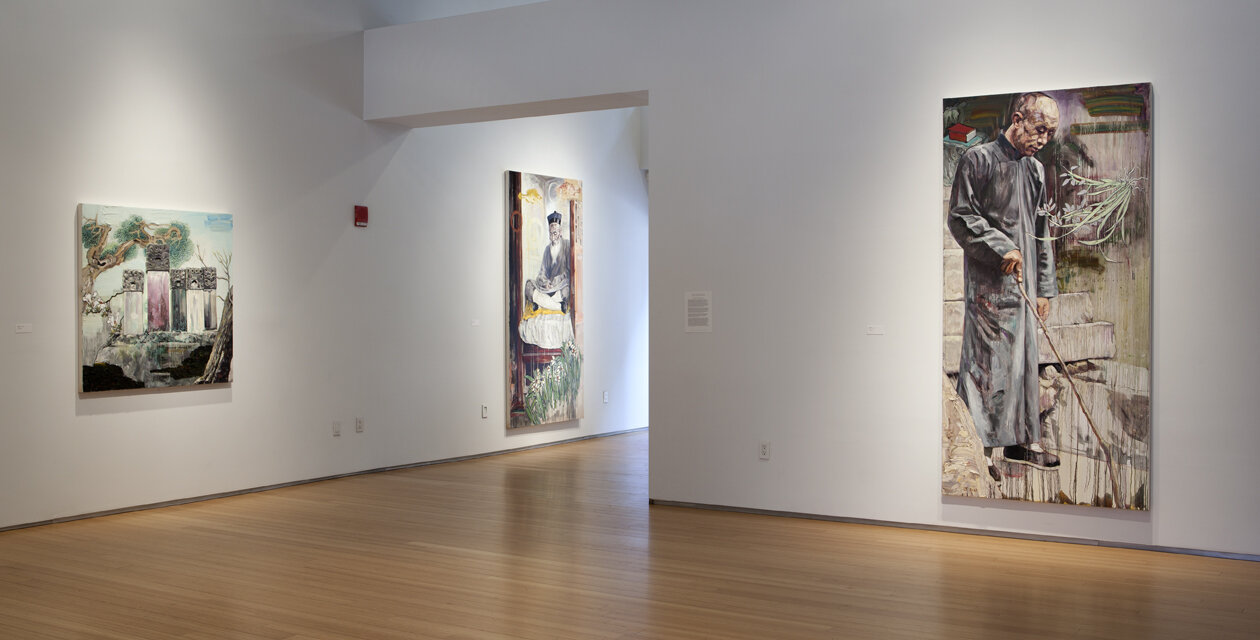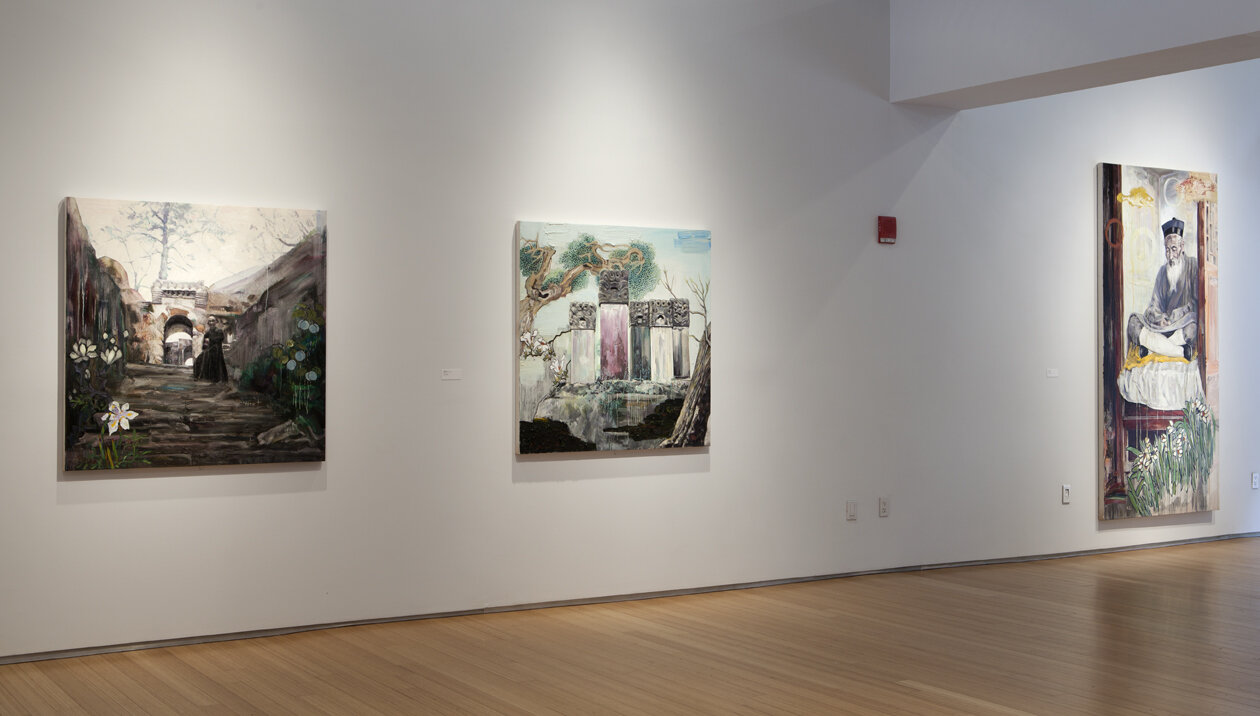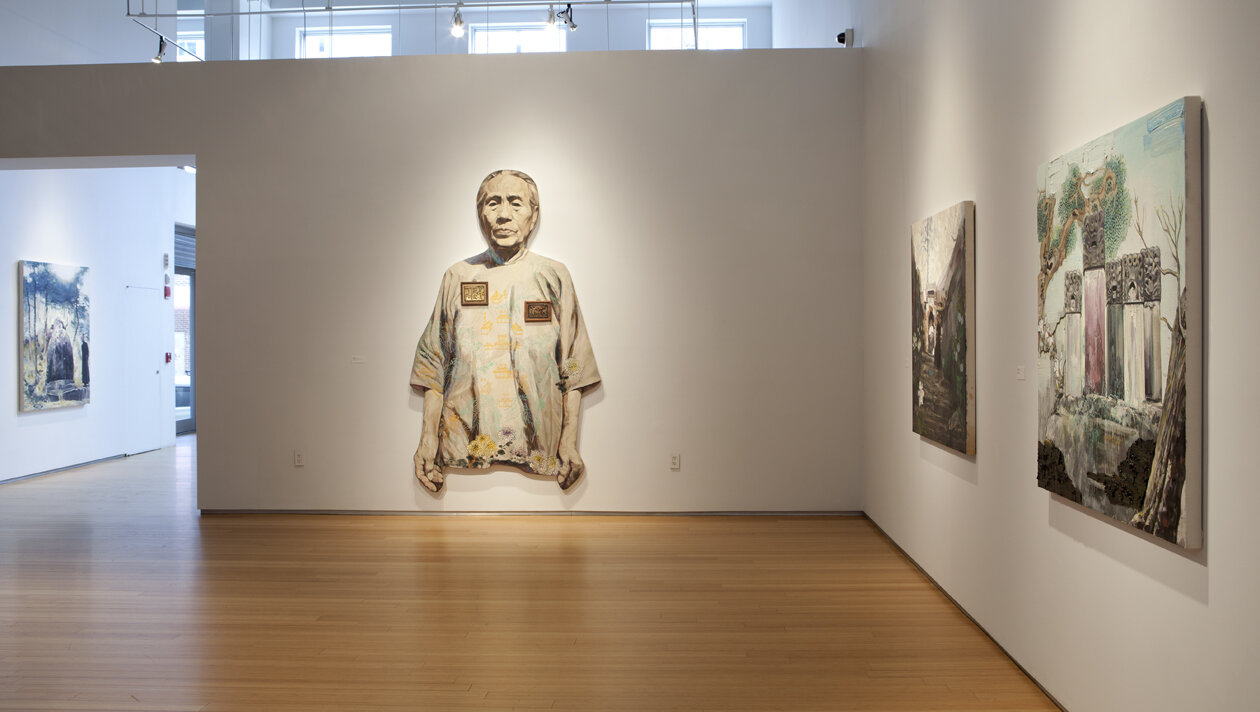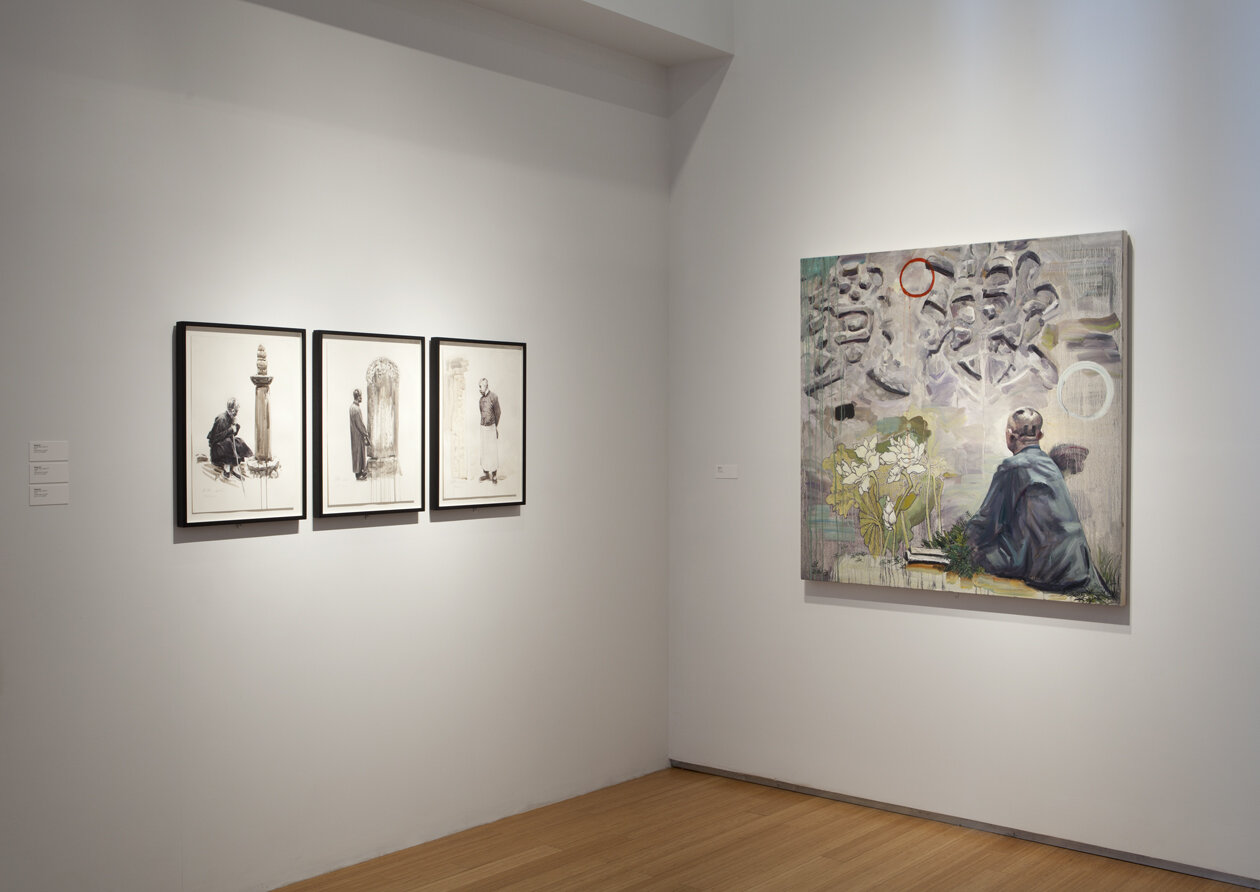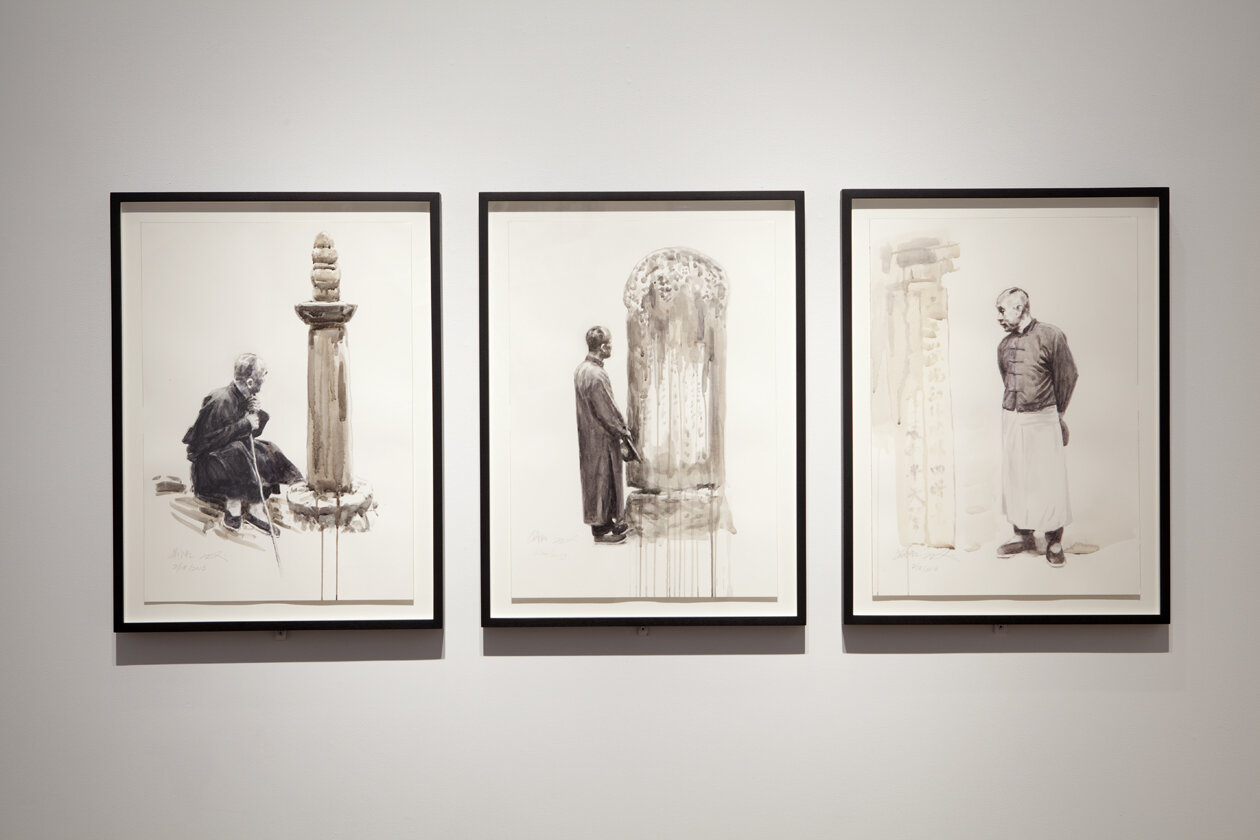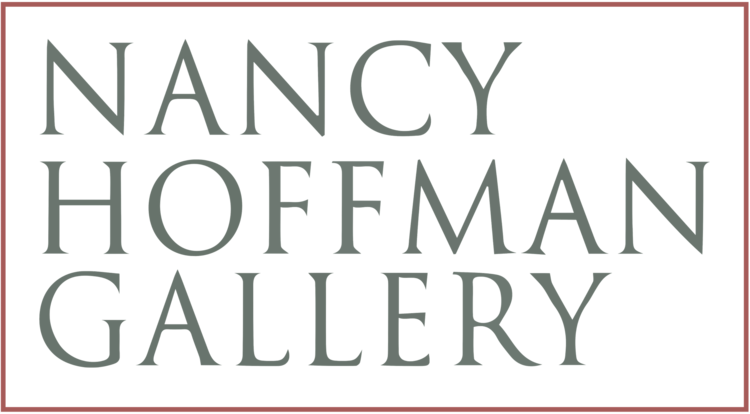Hung Liu: Qian Shan - Grandfather’s Mountain
September 12 — October 26, 2013
Qian Shan: Grandfather's Mountain-
Hung Liu's grandfather, Liu Weihua - who helped raise and educate her - was China's most important scholar on the subject of "Qianshan," a cluster of mountain peaks (nearly one thousand) in Northern China in which Taoist and Buddhist monasteries have co-existed for centuries. From his first trip there in 1919 as a student, he fell in love with the majesty of the place: with it's interwoven peaks and forests, its stairways leading to secluded temples and monastic dwellings, its upright stone steles etched with memorial and historical texts, its stone bridges leading to lonely caves, its narrow trails carved in rock ascending sacred peaks where penitents seek redemption, and he fell in love especially with its ascetic detachment from the modern world.
Throughout his adult life, and despite the facts that he was a school teacher and had a family (a wife, three girls and a boy) in Changchun (moving in the late 1950s to Beijing), Liu Weihua visited Qianshan at every opportunity, studying its temples, shrines, monasteries, and the written signs and couplets that adorned them. He collected words of wisdom left by past literati, including poetry, journals, steles, and other writings. When new discoveries were brought to his attention, he visited Qianshan and recorded them personally.
Often, he hired a photographer to document his journeys, shooting over 380 photographs of local sights, preserving Qianshan’s history and scenery, and recording the monastic lives of its priests and nuns. He also had himself photographed in Qianshan, almost as if he were a monk wandering contemplatively among the monasteries.
Now, in honor of her grandfather's scholarly work, Hung Liu has completed a new body of paintings based on photographs taken during his many research trips to Qianshan. The exhibition at the Nancy Hoffman Gallery in New York is called "Qianshan: Grandfather's Mountain." Liu is well known for basing her large, often drippy oil paintings on Chinese historical photographs, often of young prostitutes or war refugees, and her subjects are usually anonymous, lost to history. With her new paintings, "Qianshan: Grandfather's Mountain," Liu works from photographs that her grandfather commissioned, either of the landscape, religious sites or shrines, the monks and nuns who lived there, or, very often, of himself posing like a scholar tourist in his personal heaven-on-earth. As a painter, Liu is trying to bring his photographs into the 21st century as contemporary oil paintings.
The Wall Street Journal recently called Hung Liu "the greatest Chinese painter in the U.S.," and one of the reasons why is because of the depth of her connection with the culture and history of China. That connection runs not only through her own life, but through the lives and experiences of her mother and grandfather (who was born during the Qing Dynasty). As an artist, Liu has always tried to turn old photographs into new paintings, adding a certain "mineral" urgency to a
decaying "chemical" surface. With "Qianshan: Grandfather's Mountain," she makes clear the depth of her family's memory of the old, literati traditions of China with paintings that reawaken her grandfather's dream of being what the Chinese called "Jushi" (lay Buddhist), or a monk with a family.
Liu's recent career retrospective at the Oakland Museum of California was called "Summoning Ghosts: The Art and Life of Hung Liu." Throughout her career, the grainy anonymity of her historical subjects, whose fleeting images were captured in old photographs, were the ghosts she set free in her paintings. There were many ghosts in Hung Liu's life: Mao Zedong, whose omnipresent visage made private life impossible; Liu's father, a Captain in the Nationalist army who was taken away by the Communists in 1948 (and did not see his daughter again until 1994); her mother, who was both mother and father, and who died in 2011; and her grandfather, who - although he died in 1962 - remained the most inspiring figure in her life.
Liu Weihua's book on Qianshan was finally published in 2002 in China, 40 years after his death, 70 some years after he started his research.
Hung Liu, with husband Jeff Kelley and mother Liu Zongguang (Liu Weihua's daughter) visited Qian Shan in the early summer of 2006
- Jeff Kelly
Hung Liu was born in Changchun, China in 1948. She grew up in Beijing during the time of Mao Zedong. After finishing high school in 1968 she was sent to the countryside for four years during the Cultural Revolution where she worked with peasants in rice, wheat, and cornfields seven days a week. During this time, she photographed local farmers with their families and also made drawings of them. In 1972 she entered the Revolutionary Entertainment Department of Beijing’s Teachers College to study art and education. After graduating in 1975 she began teaching art at an elite Beijing school, Jing Shan, and also began to teach a program for children on television, “How to Draw and Paint,” which lasted several years and was renowned. In 1979 she attended the Central Academy of Fine Arts where she majored in mural painting. In 1980 she applied to the visual arts program at the University of California, San Diego. After being accepted, it took Liu four years to obtain a passport from the Chinese government. She arrived in California in 1984.
Hung Liu’s work has been shown at the Brooklyn Museum of Art, New York; The Corcoran Gallery of Art, Washington, D.C.; Contemporary Museum, Baltimore, Maryland; The Chrysler Museum, Norfolk, Virginia; Denver Art Museum, Colorado; The Fine Arts Museums of San Francisco, de Young Museum, California; Fort Wayne Museum of Art, Indiana; Heckscher Museum of Art, Huntington, New York; Fred Jones Jr. Museum of Art, University of Oklahoma, Norman; John Michael Kohler Arts Center, Sheboygan, Wisconsin; Knoxville Museum of Art, Tennessee; Santa Clara University, California; Monterey Museum of Art, California; Oakland Museum of California; New Britain Museum of American Art, Connecticut; Polk Museum of Art, Lakeland, Florida; Rutgers University, Paul Robeson Gallery, Newark, New Jersey; San Francisco Museum of Modern Art, California; San Jose Museum of Art, California; Smithsonian Institution, Washington, D.C.; Taipei Fine Arts Museum, Taiwan, Republic of China.
The artist’s work is included in the collections of Boise Art Museum, Idaho; Brooklyn Museum of Art, Brooklyn, New York; City of San Jose, California; Crocker Art Museum, Sacramento, California; Dallas Museum of Art, Texas; The Fine Arts Museums of San Francisco, de Young Museum, California; Fort Wayne Museum of Art, Indiana; Kemper
Museum of Contemporary Art and Design, Kansas City, Missouri; Los Angeles County Museum of Art, California; New Britain Museum of American Art, Connecticut; National Museum of American Art, Washington, D.C.; National Museum of Women in Art, Washington, D.C.; Oakland Museum Of California; San Francisco Museum of Modern Art, California; San Jose Museum of Art, California; Santa Barbara Museum of Art, California; Walker Art Center, Minneapolis, Minnesota; The Whitney Museum of American Art, New York.
She has received commissions for public art projects from Capp Street Project, San Francisco; City of Cerritos; Civic Center, San Francisco; Embarcadero Center, San Francisco; Moscone Convention Center, San Francisco; Oakland International Airport; San Jose Museum of Art and the City of San Jose Collection; University of California, San Diego, all in California, and at the Center Academy of Fine Arts, Beijing, China.
The artist has twice received a Painting Fellowship from the National Endowment for the Arts; Capp Street Project Stipend, California College of Arts & Crafts, San Francisco; Eureka Fellowship in Painting, The Fleishhacker Foundation, San Francisco, California; The Joan Mitchell Foundation, Painters Sculptors Grant, New York, New York; Russell Foundation Grant, University of California, San Diego. She has won the San Francisco Women’s Center Humanities Award, California; Contemporary Art by Women of Color Artists’ Award, Guadalupe Cultural Center, San Antonio, Texas and Society for the Encouragement of Contemporary Art (SECA) Award, San Francisco Museum of Modern Art, California. She was Distinguished Artist in Residence, Jerome M. and Wanda Otey Westheimer Chair, University of Oklahoma, Norman, and has also received grants and scholarships from the University of California, San Diego and Mills College, Oakland, California.
Hung Liu resides in Oakland, California.
For further information and/or photographs please call 212-966-6676 or email info@nancyhoffmangallery.com
Hoffman Gallery at info@nancyhoffmangallery.com. Yours sincerely,
Nancy Hoffman
